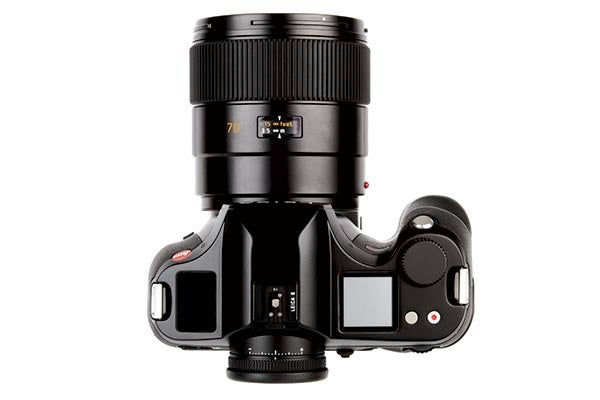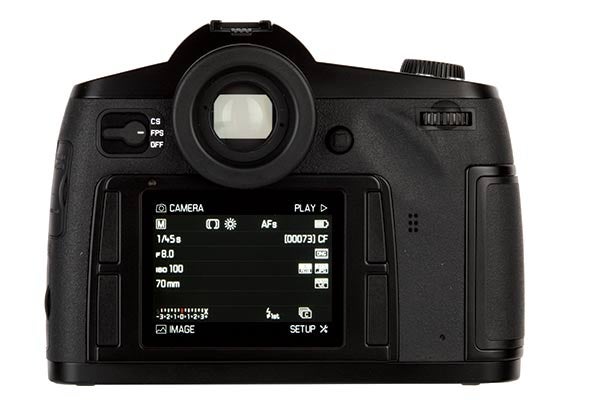Medium-format cameras are turning to the CMOS sensor for its flexibility, and Leica has followed suit with the S (Typ 007). Damien Demolder puts it to the test
Leica S (Typ 007) review
Leica S (Typ 007) review – Handling

If you are used to a 35mm-style DSLR, you’ll find the Leica S has a very familiar feel. It is shaped like a DSLR and is, in fact, a DSLR – with an eye-line optical viewfinder, a substantial grip and the shutter release in exactly the place you’d expect to find it. The top-plate offers a large command dial and the rear features a further dial, an eight-way toggle switch and four buttons positioned neatly around the rear screen. It will feel like home from home. It is, of course, bigger and heavier than a normal 35mm-style DSLR, but not excessively so – I was still able to carry it in the pocket of my favourite green coat when it was unzipped to the expanded position.
A great handling improvement for this body is the new LCD screen on the top-plate. The unit used on the Typ 006 was very difficult to see outside, but this new screen is bright and clear in all conditions and easy to use, with especially large typography.

There is a bit of delay on start-up while the camera finds the memory card, which I found a bit boring when I was in a hurry to get a shot, so I tried to just keep the camera on, but the delay occurs coming back from sleep mode too. Dialling in the settings you want to use is as easy as can be, and the rear dial can be turned to control the aperture and can be pressed in to adjust the exposure mode. A top-plate button takes us straight to the live view mode with a single press, while a second press gives us access to exposure preview and audio levels in a cropped 16×9 view.
Leica has unified its menu system across its whole camera range, so the menu in the S is basically the same as that in the Q compact and the M (Typ 240). It is a decent idea as it means Leica users will know where to find what they need immediately, no matter which camera they have come from, and the menu is good enough that it deserves to be repeated in multiple bodies.
Another element of the handling that the company is carrying from camera to camera is the arrangement of four long buttons around the rear screen. These are unmarked and customisable, so users can set them up to operate whatever features they use most often. The buttons are all dual-function as well, so a short press accesses one feature while a long press accesses another. All the short presses take us to menu screens and long presses give us functions such as ISO settings, metering modes or AF modes. It is pretty neat in one way, but you really have to remember which button you’ve set up for which function. That shouldn’t be an issue for those using the camera every day, but more occasional users may need a refresh before they get going.
The other point is that the body has only these buttons to deliver the entire content of its feature-set, and while we have smooth access to four of those features at any one time, there are plenty of others we need regular access to that can’t have a dedicated button to liberate them from the menu screens. The four-button arrangement looks very cool, but there were more than a few occasions when I wished there were more.

The camera has a new shutter system that is designed to reduce the impact of the curtain’s passing, the mirror flipping up and the shutter re-cocking. The process still creates a lot of vibration in the body, so faster shutter speeds than usual are needed, but for the most part the clatter and banging around is reduced. The company also now guarantees the shutter unit for 150,000 actuations instead of just 100,000.
The AF is decent enough in good light, and while the elements are inevitably big and heavy, focus is acquired in a reasonable amount of time. I found the system pretty good and the focus accurate, although I was always looking for more AF points across the frame.
Additional AF points are available in live-view mode, and they can be accessed using the joystick on the rear of the camera to shift the focusing marker across the screen until it almost reaches the edges. The marker moves pretty quickly and the action of shooting in live view is not so prolonged that it can’t be managed handheld – at a short shutter speed. It isn’t ideal, of course, and isn’t much good for moving subjects, but it can be done and is useful for off-centre subjects shot at wide apertures. With the camera tripod mounted live view comes into its own, and small details can be used as focus references in landscapes and so on.
For occasions when depth of field is critical, we have a standard stop-down depth of field preview button that works nicely in the bright optical finder as well as in live-view mode. The top-plate display also houses a depth of field information panel that shows the distances for our focused point, as well as the closest and furthest objects that will be sharp at the given aperture, which is pretty useful.




